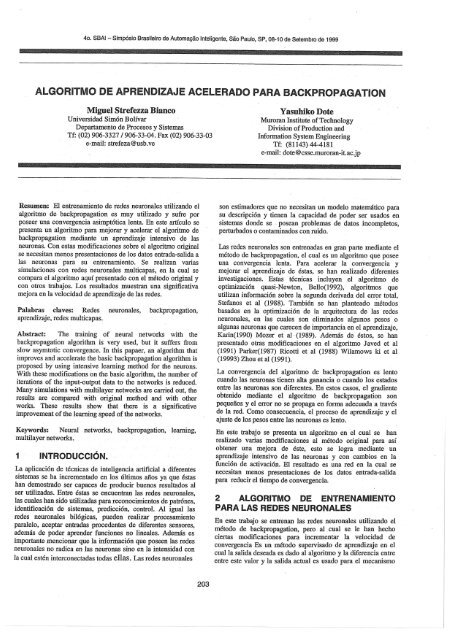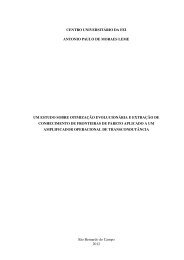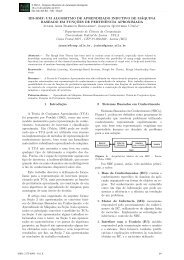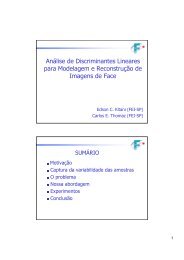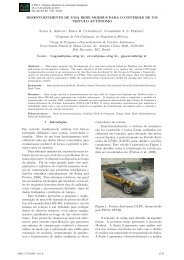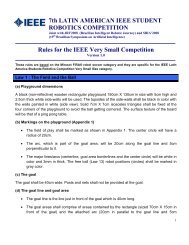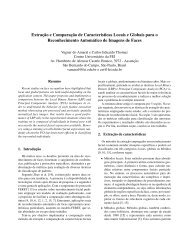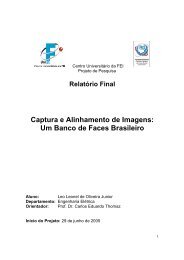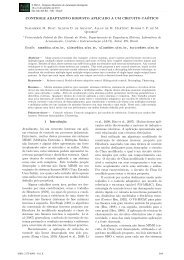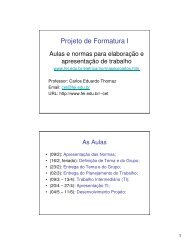algoritmo de aprendizaje acelerado para backpropagation - Fei
algoritmo de aprendizaje acelerado para backpropagation - Fei
algoritmo de aprendizaje acelerado para backpropagation - Fei
You also want an ePaper? Increase the reach of your titles
YUMPU automatically turns print PDFs into web optimized ePapers that Google loves.
40. SBAI-Simpósio Brasileiro <strong>de</strong> Automação Inteligente, São Paulo, SP, 08-10 <strong>de</strong> Setembro <strong>de</strong> 1999<br />
ALGORITMO DE APRENDIZAJE ACELERADO PARA BACKPROPAGATION<br />
Miguel Strefezza Bianco<br />
Universidad Simón Bolivar<br />
Departamento <strong>de</strong> Procesos y Sistemas<br />
Tf: (02) 906-3327 / 906-33-04. Fax (02) 906-33-03<br />
e-mail: strefeza@usb.ve<br />
Resumen: El entrenamiento <strong>de</strong> re<strong>de</strong>s neuronales utilizando el<br />
<strong>algoritmo</strong> <strong>de</strong> <strong>backpropagation</strong> es muy utilizado y sufre por<br />
poseer una convergencia asimptótica lenta. En este artículo se<br />
presenta un <strong>algoritmo</strong> <strong>para</strong> mejorar y acelerar el <strong>algoritmo</strong> <strong>de</strong><br />
<strong>backpropagation</strong> mediante un <strong>aprendizaje</strong> intensivo <strong>de</strong> las<br />
neuronas. Con estas modificaciones sobre el <strong>algoritmo</strong> original<br />
se necesitan menos presentaciones <strong>de</strong> los datos entrada-salida a<br />
las neuronas <strong>para</strong> su entrenamiento. Se realizan varias<br />
simulaciones con re<strong>de</strong>s neuronales multicapas, en la cual se<br />
com<strong>para</strong> el <strong>algoritmo</strong> aquí presentado con el método original y<br />
con otros trabajos. Los resultados muestran una significativa<br />
mejora en la velocidad <strong>de</strong> <strong>aprendizaje</strong> <strong>de</strong> las re<strong>de</strong>s.<br />
Palabras claves: Re<strong>de</strong>s neuronales, <strong>backpropagation</strong>,<br />
<strong>aprendizaje</strong>, re<strong>de</strong>s multicapas.<br />
Abstract: The training of neural networks with the<br />
<strong>backpropagation</strong> algorithm is very used, but it suffers from<br />
slow asymtotic convergence. In this papaer, an algorithm that<br />
improves and accelerate the basíc <strong>backpropagation</strong> algorithm is<br />
proposed by using intensive learning method for the neurons.<br />
With these modifications on the basic algorithm, the number of<br />
iterations of the input-output data to the networks is reduced.<br />
Many simulations with multilayer networks are carried out, the<br />
results are compared with original method and with other<br />
works. These .results show that there is a significative<br />
improvement of the learning speed ofthe networks.<br />
Keywords: Neural networks, <strong>backpropagation</strong>, learning,<br />
multilayer networks.<br />
1 INTRODUCCIÓN.<br />
La aplicación <strong>de</strong> técnicas <strong>de</strong> inteligencia artificial a diferentes<br />
sistemas se ha incrementado en los últimos aãos ya que éstas<br />
han <strong>de</strong>mostrado ser capaces <strong>de</strong> producir buenos resultados al<br />
ser utilizadas. Entre éstas se encuentran las re<strong>de</strong>s neuronales,<br />
las cuales han sido utilizadas <strong>para</strong> reconocimientos <strong>de</strong> patrónes,<br />
i<strong>de</strong>ntificación <strong>de</strong> sistemas, predicción, controI. AI igual las<br />
re<strong>de</strong>s neuronales bilógicas, pue<strong>de</strong>n realizar procesamiento<br />
<strong>para</strong>lelo, aceptar entradas proce<strong>de</strong>ntes <strong>de</strong> diferentes sensores,<br />
a<strong>de</strong>más <strong>de</strong> po<strong>de</strong>r apren<strong>de</strong>r funciones no Iineales. A<strong>de</strong>más es<br />
importante mencionar que la información que poseen las re<strong>de</strong>s<br />
neuronales no radica en las neuronas sino en la intensidad con<br />
la cual estén interconectadas todas ellas. Las re<strong>de</strong>s neuronales<br />
203<br />
Yasuhiko Dote<br />
Muroran Institute ofTechnology<br />
Division ofProduction and<br />
Information System Engineering<br />
Tf: (81143) 44-4181<br />
e-mail: dote@csse.muroran-it.ac.jp<br />
son estimadores que no necesitan un mo<strong>de</strong>lo matemático <strong>para</strong><br />
su <strong>de</strong>scripción y tienen la capacidad <strong>de</strong> po<strong>de</strong>r ser usados en<br />
sistemas don<strong>de</strong> se .posean problemas <strong>de</strong> datos incompletos,<br />
perturbados o contaminados con ruido.<br />
Las re<strong>de</strong>s neuronales son entrenadas en gran parte mediante el<br />
método <strong>de</strong> <strong>backpropagation</strong>, el cuai es un <strong>algoritmo</strong> que posee<br />
una convergencia lenta. Para acelerar la convergencia y<br />
mejorar el <strong>aprendizaje</strong> <strong>de</strong> éstas, se han realizado . diferentes<br />
investigaciones. Estas técnicas incluyen el <strong>algoritmo</strong> <strong>de</strong><br />
optimización quasi-Newton, Bello(1992), <strong>algoritmo</strong>s que<br />
utilizan información sobre la segunda <strong>de</strong>rivada <strong>de</strong>l error total,<br />
Stefanos et al (1988). También se han planteado métodos<br />
basados en la optimización <strong>de</strong> la arquitectura <strong>de</strong> las re<strong>de</strong>s<br />
neuronales, en las cuales son eliminados algunos pesos o<br />
algunas neuronas que carecen <strong>de</strong> importancia en el aprend izaje,<br />
Karin(1990) Mozer et al (1989). A<strong>de</strong>más <strong>de</strong> éstos, se han<br />
ptesentado otras modificaciones en el <strong>algoritmo</strong> Javed et al<br />
(1991) Parker(1987) Ricotti et ai (1988) Wilamows lei et al<br />
(19993) Zhou et aI (1991).<br />
La convergencia <strong>de</strong>i <strong>algoritmo</strong> <strong>de</strong> <strong>backpropagation</strong> es lento<br />
cuando las neuronas tienen alta ganancia ocuando los estados<br />
entre las neuronas son diferentes. En estos casos, el gradiente<br />
obtenido mediante el <strong>algoritmo</strong> <strong>de</strong> <strong>backpropagation</strong> son<br />
pequenos y el error no se propaga en forma a<strong>de</strong>cuada a través<br />
<strong>de</strong> la red. Como consecuencia, el proceso <strong>de</strong> <strong>aprendizaje</strong> y el<br />
ajuste <strong>de</strong> los pesos entre las neuronas es lento.<br />
En este trabajo se presenta un <strong>algoritmo</strong> en el cual se han<br />
realizado varias modificaciones ai método original <strong>para</strong> así<br />
obtener una mejora <strong>de</strong> éste, esto se logra mediante un<br />
<strong>aprendizaje</strong> intensivo <strong>de</strong> las neuronas y con cambios en la<br />
función <strong>de</strong> activaci6n. EI resultado es una red en la cual se<br />
necesitan menos presentaciones <strong>de</strong> los datos entrada-salida<br />
<strong>para</strong> reducir el tiempo <strong>de</strong> convergencia.<br />
2 ALGORITMO DE ENTRENAMIENTO<br />
PARA LAS REDES NEURONALES<br />
En este trabajo se entrenan las re<strong>de</strong>s neuronales utilizando el<br />
método <strong>de</strong> <strong>backpropagation</strong>, pero ai cual se le han hecho<br />
ciertas modificaciones <strong>para</strong> incrementar la velocidad <strong>de</strong><br />
convergencia Es un método supervisado <strong>de</strong> <strong>aprendizaje</strong> en· el<br />
cual la salida <strong>de</strong>seada es dado ai <strong>algoritmo</strong> y la diferencia entre<br />
entre este valor y la salida actual es usado <strong>para</strong> el mecanismo
a) Entrada a la capa escondida o a la capa <strong>de</strong> salida.<br />
s s s-I<br />
Ij = (1)<br />
f WjiXi<br />
;=1<br />
b) Salida <strong>de</strong>s<strong>de</strong> la(s) capa(s) escondida(s) y capa <strong>de</strong> salida.<br />
xj = f(lj)<br />
c) Incremento <strong>de</strong> los pesos.<br />
.. s s s-I .. s<br />
AWj; =áe jXj +çAw ji(t-l)<br />
don<strong>de</strong> 11 es el momento.<br />
d) Error en la capa <strong>de</strong> salida.<br />
= -(d k<br />
e) Error local.<br />
o.<br />
s f(ls)" s+1<br />
ej = j LJek Wkj<br />
k.el<br />
don<strong>de</strong>j{x) es la funci6n sigmoidal.<br />
40. SBAI - Simpósio Brasileiro <strong>de</strong> Automação Inteligente, São Paulo, SP, 08-10 <strong>de</strong> Setembro <strong>de</strong> 1999<br />
<strong>de</strong> adaptací õn, siendo basicamente<br />
presentadose varias modificaciones<br />
este <strong>algoritmo</strong> lento.<br />
como se mencionó<br />
So _ So s<br />
ek - -(dk - xk )lf'(Ik<br />
s g<br />
o<br />
- (dk - xk o »J (8)<br />
anteriormente. Pero alguna <strong>de</strong> elIas necesitan mucho uso <strong>de</strong> don<strong>de</strong> O
40. SBAI - Simpósio Brasileiro <strong>de</strong> Automação Inteligente, São Paulo, SP, 08·10 <strong>de</strong> Setembro <strong>de</strong> 1999<br />
Fig. 3. patrones utilizados <strong>para</strong> el <strong>aprendizaje</strong> <strong>de</strong> las letras.<br />
Tabla 1. Datos <strong>de</strong> entrada-salida <strong>para</strong> obtener la función <strong>de</strong> pertenencia <strong>de</strong>I error (e) y la<br />
<strong>de</strong>I cambio <strong>de</strong>l error (ê) respectivamente.<br />
ENTRADA NB NM NS ZO PS PM PB<br />
-3.0 1.0 0.0 0.0 0.0 0.0 0.0 0.0<br />
-2.3 0.7 0.3 0.0 0.0 0.0 0.0 0.0<br />
-104 0.3 0.7 0.0 0.0 0.0 0.0 0.0<br />
-0.7 0.0 l.0 0.0 0.0 0.0 0.0 0.0<br />
-0.5. 0.0 0.7 0.3 0.0 0.0 0.0 0.0<br />
0.0 0.3 0.7 0.0 0.0 0.0 0.0<br />
-0.1 0.0 0.0 1.0 0.0 0.0 0.0 0.0<br />
-0.07 0.0 0.0 0.7 0.3 0.0 0.0 0.0<br />
-0.03 0.0 0.0 0.3 0.7 0.0 0.0 0.0<br />
0.0 0.0 0.0 0.0 1.0 0.0 0.0 0.0<br />
0.03 0.0 0.0 0.0 0.7 0.3 0.0 0.0<br />
0.07 0.0 0.0 0.0 0.3 0.7 0.0 0.0<br />
0.1 0.0 0.0 0.0 0.0 1.0 0.0 0.0<br />
0.3 0.0 0.0 0.0 0.0 0.7 0.3 0.0<br />
0.5 0.0 0.0 0.0 0.0 0.3 0.7 0.0<br />
.0.7 0.0 0.0 0.0 0.0 0.0 1.0 0.0<br />
IA 0.0 0.0 0.0 0.0 0.0 0.7 0.3<br />
2.3 0.0 0.0 0.0 0.0 0.0 0.3 0.7<br />
. 3.0 0.0 0.0 . 0.0 0.0 0.0 0.0 1.0<br />
la capa escondida y se obtuvieron resultados satisfactorios con<br />
.solamente 140 iteraciones. Si com<strong>para</strong>mos esto con el método<br />
tradicional esto neéesitará unas 7000. En el mejor caso <strong>de</strong> en<br />
presentado por. Zhou et ai (1991), se necesítaron 1209<br />
iteraciones el caso; en e1 presentado en Javed et ai ( 1991)<br />
unas 250 y <strong>de</strong> Wilamowski et aI (1993), 500 presentaciones.<br />
Como segundo ejemplo tenemos el problema <strong>de</strong> simetria, en el<br />
cual se utilizaron 5 neuronas en la capa escondida,<br />
necesitandose 180 iteraciones <strong>para</strong> el entrenamiento <strong>de</strong> la red.<br />
Con el método tradicional se necesitan unas 8000, y en e1<br />
mejor caso <strong>de</strong> Zhou et aI (1991), se necesitaron 1290.<br />
Otro caso que se tomó fue el reconocimiento <strong>de</strong> letras, se<br />
realizaron experiencias con matrices <strong>de</strong> ·llx11 y <strong>de</strong> 5x5,<br />
utilizandose las letras <strong>de</strong> la "A" hasta la "F', teniendose 5<br />
neuronas en la capa escondida, los patrones utilizados se<br />
observan en la Fig. 3. Para el <strong>aprendizaje</strong> <strong>de</strong> estas re<strong>de</strong>s se<br />
205<br />
ENTRADA NB NM ·NS ZO PS PM PB<br />
-004 1.0 0.0 0.0 0.0 0.0 0.0 0.0<br />
-0.34 0.7 0.3 0.0 0.0 0.0 0.0 0.0<br />
-0.26 0.3 0.7 0.0 0.0 0.0 0.0 0.0<br />
-0.2 0.0 1.0 0.0 0.0 0.0 0.0 0.0<br />
-0.16 0.0 0.7 0.3 0.0 0.0 0.0 0.0<br />
-0.09 0.0 0.3 0.7 0.0 0.0 0.0 0.0<br />
-0.05 0.0 0.0 1.0 0.0 0.0 0.0 0.0<br />
-0.035 0.0 0.0 0.7 0.3 0.0 0.0 0.0<br />
-0.015 0.0 0.0 0.3 0.7 0.0 0.0 0.0<br />
0.0 0.0 0.0 0.0 1.0 0.0 0.0 0.0<br />
0.015 0.0 0.0 0.0 0.7 0.3 0.0 0.0<br />
0.035 0.0 0.0 0.0 0.3 0.7 0.0 0.0<br />
0.05 0.0 0.0 0.0 0.0 1.0 0.0 0.0<br />
0.09 0.0 0.0 0.0 0.0 0.7 0.3 0.0<br />
0.16 0.0 0.0 0.0 0.0 0.3 0.7 0.0<br />
0.2 0.0 0.0 0.0 0.0 0.0 1.0 0.0<br />
0.26 0.0 0.0 0.0 0.0 0.0 0.7 0.3<br />
0.34 0.0 0.0 0.0 0.0 0.0 0.3 0.7<br />
004 0.0 0.0 0.0 0.0 0.0 0.0 1.0<br />
necesitaron con el <strong>algoritmo</strong> propuest 50 interaciones con lo<br />
que obtenia una certeza <strong>de</strong>I 95% o más en el caso afirmativo y<br />
0.01% o menos <strong>para</strong> los casos negativos. También se consi<strong>de</strong>ró<br />
la presencia <strong>de</strong> ruido en los patrones <strong>de</strong> las letras, obteniendose<br />
un 85% o más en los casos afirmativos. Con el <strong>algoritmo</strong><br />
original esto necesitaría unas 3000 iteraciones.<br />
Como último caso presentarernos el <strong>aprendizaje</strong> <strong>de</strong> funciones<br />
<strong>de</strong> las pertenencia <strong>de</strong>I error (e) y <strong>de</strong>I cambio <strong>de</strong>I error (6), así<br />
corno <strong>de</strong> la tab1a <strong>de</strong> búsqueda utilizada <strong>para</strong> controladores<br />
borrosos, lo cual pue<strong>de</strong> ser útil en el área <strong>de</strong> control Hayashi et<br />
aI (1989) Strefezza (1994) Yarnaokaet aI (1990).<br />
Para las funciones <strong>de</strong> pertenencia, se entrenan dos re<strong>de</strong>s<br />
neuronales, las cuales poseen respectivamente tres capas con 1,<br />
6 y 7 neuronas respectivamente. Esto implica que se están<br />
tornando siete variables borrosas. De igual forma, los datos <strong>de</strong><br />
entrada-salida <strong>para</strong> cada una <strong>de</strong> las re<strong>de</strong>s se muestran en la
40. SBAI-Simpósio Brasileiro <strong>de</strong> Automação Inteligente, São Paulo, SP, 08-10 <strong>de</strong> Setembro <strong>de</strong> 1999<br />
Tabla 1 respectivamente. EI resultado <strong>de</strong>I entrenamiento <strong>de</strong><br />
estas re<strong>de</strong>s se pue<strong>de</strong>n observar en las Fig. 4 Y Fig. 5<br />
respectivamente. Con :el <strong>algoritmo</strong> arriba propuesto, se<br />
necesitan menos <strong>de</strong> 260 presentaciones <strong>de</strong> los datos entradasalida<br />
<strong>para</strong> entrenar a cada una <strong>de</strong> las re<strong>de</strong>s, con el método<br />
tradicional <strong>de</strong> backpropagarion son necesarias más <strong>de</strong> 3000<br />
presentaciones. .<br />
En cuanto a la tabla <strong>de</strong> busqueda, también se utiliza una red<br />
neuronaI <strong>de</strong> tres capas con 14, 6 y 7 neuronas en cada capa. La<br />
tabla <strong>de</strong> busqueda utilizada se muestra en la Tabla 2, siendo<br />
utilizados soIamente 1's y O's <strong>para</strong> su entrenamiento. Con las<br />
ecuaciones modificadas se necesitaron menos <strong>de</strong> 100<br />
presentaciones <strong>de</strong> los datos entrada-salida <strong>para</strong> entrenar esta<br />
Grado <strong>de</strong> pertenenecia<br />
1.0 <strong>de</strong>I error<br />
Fig, 4. Función <strong>de</strong> pertenencía <strong>de</strong>l error (e) obtenida Iuego<br />
<strong>de</strong> utilizar los datos <strong>de</strong> la labia 1.<br />
-4.0<br />
Grado <strong>de</strong> pertenencia<br />
I. o. <strong>de</strong>i cambio <strong>de</strong>l error<br />
Fig. 5. Función <strong>de</strong> pertenencia <strong>de</strong>i cambio error (ti )<br />
obtenida Iuego <strong>de</strong> utilizar los datos <strong>de</strong> la tabla 1.<br />
red. EI método convencional necesita más <strong>de</strong> 3000 <strong>para</strong> obtener<br />
el mismo resultado.<br />
4 CONCLUSIONES<br />
4.0<br />
Cambio <strong>de</strong>i crror (xlO' l )<br />
En este trabajo se han entrenado las re<strong>de</strong>s neuronales con un<br />
<strong>algoritmo</strong> modificado <strong>de</strong> <strong>backpropagation</strong>, el cual no es dificil<br />
<strong>de</strong> implementar ya que no necesita. Este reduce en un gran<br />
porcentaje el número <strong>de</strong> iteraciones que hay que realizar <strong>de</strong><br />
206<br />
Cambio <strong>de</strong>I Error ( é )<br />
Error(e) NB NM N's ZO PS PM PB<br />
NR NB NB NB NB NB NR NB<br />
NM NB NB NB NM NM NM NM<br />
NS NB NM NM NS NS NS NS<br />
ZO NM NS ZO ZO ZO PS PM<br />
PS PS PS PS PS PM PM PB<br />
PM PM PM PM PM PB PB PN<br />
PB PB PB PB PB PB PB PB<br />
Tabla 2. Tabla <strong>de</strong> busqueda utilizada <strong>para</strong> entrenar la red<br />
neuronal.<br />
datos <strong>para</strong> obtener su convergencia y así reducir el tiempo <strong>de</strong><br />
<strong>aprendizaje</strong>.<br />
Se realizaron experiencias con diferentes tipos <strong>de</strong> data y <strong>de</strong><br />
patrones, a<strong>de</strong>más <strong>de</strong> com<strong>para</strong>se con otros métodos propuestos<br />
en la literatura, obteniendose resultados satisfactorios.<br />
Com<strong>para</strong>ndo con eI <strong>algoritmo</strong> original. La diferencia entre los<br />
porcentajes <strong>de</strong> respuesta afirmativa y negativa a la salida <strong>de</strong> la<br />
red lo suficientemente gran<strong>de</strong>, en casos <strong>de</strong> entrenamientos <strong>de</strong><br />
patrones compuestos <strong>de</strong> O's y 1's, EI <strong>algoritmo</strong> presentado<br />
también pue<strong>de</strong> ser utilizado en caso <strong>de</strong> diseiíar sistemas <strong>de</strong><br />
control.<br />
En el <strong>algoritmo</strong> presentado se <strong>de</strong>ben ajustar ciertas variables<br />
por ensayo y error, al igual que en otros <strong>algoritmo</strong>s, por lo que<br />
siempre existe la posibilidad <strong>de</strong> saturación <strong>de</strong> las neuronas<br />
impidiendo un <strong>aprendizaje</strong> correcto <strong>de</strong> los patrones presentados<br />
a las re<strong>de</strong>s.<br />
5 REFERENCIAS BIBLIOGRÁFICAS<br />
Bello, M.G.(1992). Enhanced Training AIgorithms, and<br />
integrated training/architecturc selection for Multilayer<br />
Perceptron .Networks. IEEE Transactions on Neural<br />
Networks, VoI. 3, November.<br />
Driankov, D., HeIlendoorn, H. and Reinfrank, M. (1993). An<br />
Introduction to Fuzzy ControI. Springer-Verlag. .<br />
Hayashi, 1., Nomura, H. and Wakami, N. (1989). Artificial<br />
Neural Network Driven Fuzzy Control and its Application<br />
to the Lerarning of Inverted Pendulum System. 3 rtf • IFSA<br />
Congress, Japón (1989). 610-613.<br />
Jang, J.-S.R., Sun,C.-T. and Mizutani, E.(1997l.Neuro-Fuzzy<br />
and Soft Computing. Prentice HaIl, 1997. .<br />
Javed, M.A. and San<strong>de</strong>rs S.AC (1991).An Adaptive Learning<br />
Procedure for ' Neural Networks In ' engineering<br />
Applications. Intelligent Engineering Systems Through<br />
Artificial Neyral Networks. Dagli, Kimura and Shin<br />
Editors, ASME Press.<br />
Karnin, s,o. (1990). A Simple Procedure for Pruning Back-<br />
Propagation Trained Neural Networks. IEEE Transactions<br />
on Neural Networks, VoI. 1.<br />
Mozer, M.C. and Smolensky, P.(1989). Using Relevance to<br />
Reduce Network Size Automatically. Connection Science,<br />
VaI. 1.<br />
Parker, D. (1987). OptimaI Algorithm for Adaptive Networks:<br />
Second Or<strong>de</strong>r Back Propagation, Second Or<strong>de</strong>r Direct<br />
Propagation and Second Or<strong>de</strong>r Hebbian Learning. ..
40. SBAI - Simpósio Brasileiro <strong>de</strong> Automação Inteligente, São Paulo, SP, 08-10 <strong>de</strong> Setembro <strong>de</strong> 1999<br />
Proceedings of IEEE First International Conference on<br />
Neural Networs, San Diego, USA.<br />
Ricotti, L., Ragazzini, S. and Martinelli, G.(1988). Learning of<br />
Word Stress in a Sub-optimal Second Or<strong>de</strong>r<br />
Backpropagation Neural Network. Proceedings of IEEE<br />
Second Intemational Conference on Neural Networs, San<br />
Diego, USA.<br />
Stefanos, K. and Anastassiou D.(1988).Adaptive Training of<br />
Multilayer Neural Networks using a Least-squares<br />
Estimation Technique. Proceedings of the IEEE<br />
0<br />
Intemational Conference on Neural Networks , (1), 383-<br />
390.<br />
Strefezza, M. (1994). Neuro Fuzzy Robust Motion ControI.<br />
Doctoral thesis, Muroran Institute ofTechnology, Japan.<br />
Uchikawa, Y., Horikawa, S. Furuhashi, T. and Okuma,<br />
S.(1990). AFuzzy Controller using a Neural Network and<br />
its capability to Learn Experts Control Rules. Proceedings<br />
ofthe International Conference on Fuzzy Logic and Neural<br />
Networks, Japón. 103-106.<br />
Wilamowski, B.M. and Torvik, L.M.(1993). Modification of<br />
gradient Computation in the Back-Propagation A1gorithm.<br />
Intelligent Engineering Systems Through Artificial Neyral<br />
Networks. Dagli, Kimura and Shin Editors, ASME Press.<br />
Yamaoka, M. and Mukaidomo, M. (1990). A Learning<br />
Method of the Membership Function with Neural<br />
Networks. &h. Fuzzy System Symposium, Japón. 197-200.<br />
.En Japonés.<br />
Zhou, G. and Sun, Y.(1991). A Combined Gradient Learning<br />
algorithm For Multi-layered Neural Networks.<br />
Proceedings ofthe IECON'91. Japón (1991).1492-]495.<br />
207


